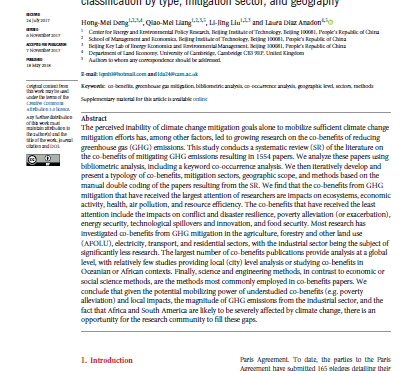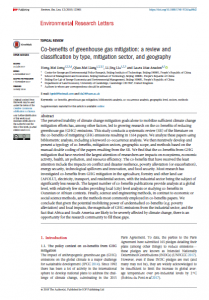The perceived inability of climate change mitigation goals alone to mobilise sufficient climate change mitigation efforts has, among other factors, led to growing research on the co-benefits of reducing greenhouse gas (GHG) emissions. This study conducts a systematic review (SR) of the literature on the co-benefits of mitigating GHG emissions resulting in 1554 papers. This study analyses these papers using bibliometric analysis, including a keyword co-occurrence analysis. It then iteratively develops and presents a typology of co-benefits, mitigation sectors, geographic scope, and methods based on the manual double coding of the papers resulting from the SR. The study finds that the co-benefits from GHG mitigation that have received the largest attention of researchers are impacts on ecosystems, economic activity, health, air pollution, and resource efficiency. The co-benefits that have received the least attention include the impacts on conflict and disaster resilience, poverty alleviation (or exacerbation), energy security, technological spillovers and innovation, and food security. Most research has investigated co-benefits from GHG mitigation in the agriculture, forestry and other land use (AFOLU), electricity, transport, and residential sectors, with the industrial sector being the subject of significantly less research. The largest number of co-benefits publications provide analysis at a global level, with relatively few studies providing local (city) level analysis or studying co-benefits in Oceanian or African contexts. Finally, science and engineering methods, in contrast to economic or social science methods, are the methods most commonly employed in co-benefits papers. The study concludes that given the potential mobilising power of understudied co-benefits (e.g. poverty alleviation) and local impacts, the magnitude of GHG emissions from the industrial sector, and the fact that Africa and South America are likely to be severely affected by climate change, there is an opportunity for the research community to fill these gaps.
Region: Not specific
Date published:
2018
Published by:
Environmental Research Letters
Type of resource:
Journal article
Resource topic:
Climate change
Project/Programme: Not specific
Pest/Disease: Not specific
Pages:
27
File type:
External link (3,985 KB)




